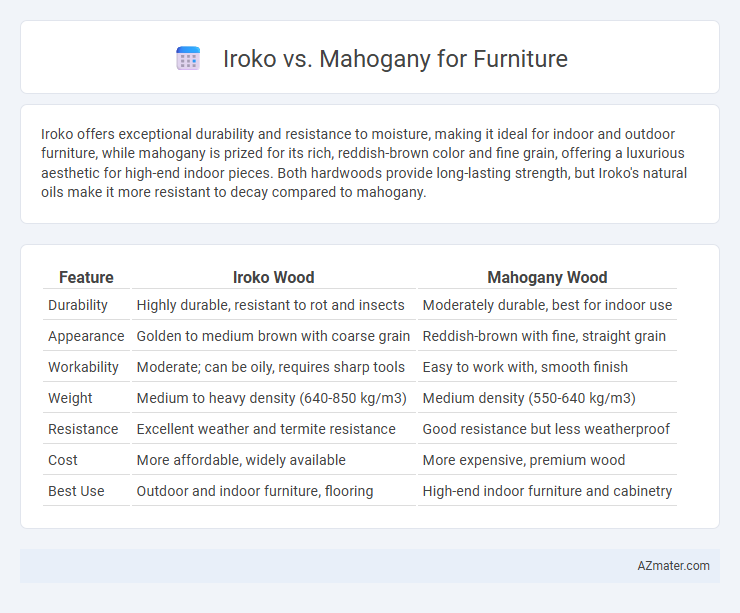Iroko offers exceptional durability and resistance to moisture, making it ideal for indoor and outdoor furniture, while mahogany is prized for its rich, reddish-brown color and fine grain, offering a luxurious aesthetic for high-end indoor pieces. Both hardwoods provide long-lasting strength, but Iroko's natural oils make it more resistant to decay compared to mahogany.
Table of Comparison
| Feature | Iroko Wood | Mahogany Wood |
|---|---|---|
| Durability | Highly durable, resistant to rot and insects | Moderately durable, best for indoor use |
| Appearance | Golden to medium brown with coarse grain | Reddish-brown with fine, straight grain |
| Workability | Moderate; can be oily, requires sharp tools | Easy to work with, smooth finish |
| Weight | Medium to heavy density (640-850 kg/m3) | Medium density (550-640 kg/m3) |
| Resistance | Excellent weather and termite resistance | Good resistance but less weatherproof |
| Cost | More affordable, widely available | More expensive, premium wood |
| Best Use | Outdoor and indoor furniture, flooring | High-end indoor furniture and cabinetry |
Introduction to Iroko and Mahogany
Iroko and Mahogany are prized hardwoods commonly used in fine furniture making due to their durability and aesthetic appeal. Iroko, known for its golden to medium brown color and resistance to decay, is often compared to teak for outdoor furniture applications. Mahogany features a rich reddish-brown hue and smooth grain, valued for its elegance and workability in premium indoor furniture.
Origins and Botanical Differences
Iroko wood, native to West Africa, belongs to the Chlorophora genus, primarily Chlorophora excelsa, and is renowned for its durability and natural resistance to insects and decay. Mahogany, coming from the Swietenia genus native to the Americas, especially Central America, features a fine grain and reddish-brown color, making it highly prized for its aesthetic appeal in furniture making. Botanical distinctions include Iroko's coarse texture and higher silica content versus Mahogany's smoother grain and moderate density, influencing their respective workability and finish quality in furniture production.
Appearance and Grain Patterns
Iroko wood features a yellow to golden-brown hue that darkens with age, showcasing a coarse, interlocked grain pattern with occasional wavy or ribbon-like effects, giving furniture a rustic yet sophisticated appearance. Mahogany offers a rich, reddish-brown color that deepens over time, characterized by a fine, straight grain and a smooth texture that imparts an elegant and refined look to furniture pieces. Both woods provide durability, but mahogany's consistent grain and warm tone are often preferred for classic, high-end furniture styles, while iroko's distinctive grain and color variations suit more eclectic or contemporary designs.
Durability and Hardness
Iroko wood offers exceptional durability and hardness, making it highly resistant to wear, decay, and insect infestations, which is ideal for heavy-use furniture. Mahogany also possesses significant hardness but is prized for its smooth grain and rich, reddish-brown color, though it is generally less dense and slightly softer than Iroko. Both woods provide excellent strength, but Iroko's superior hardness and resistance make it more suitable for long-lasting, robust furniture applications.
Workability and Machinability
Iroko wood offers excellent workability with a medium to coarse grain that machines well, allowing clean cuts and smooth finishes for furniture making. Mahogany is highly regarded for its superior machinability, featuring a fine, straight grain that responds effortlessly to shaping, sanding, and finishing processes. Both woods are durable, but Mahogany's ease of machining often makes it a preferred choice for intricate furniture designs requiring precision and smooth detailing.
Resistance to Pests and Decay
Iroko wood demonstrates exceptional resistance to pests and decay due to its natural oils and dense grain, making it highly durable for outdoor and indoor furniture. Mahogany, while moderately resistant to termites and fungal attacks, typically requires proper treatment to achieve long-lasting protection against pests and rot. Choosing iroko offers greater inherent durability and lower maintenance in environments prone to moisture and insect activity.
Cost and Availability
Iroko and Mahogany differ significantly in cost and availability, with Iroko generally being more affordable due to its widespread availability in West Africa. Mahogany, particularly genuine types like Honduran or African Mahogany, commands higher prices because of limited supply and greater demand in high-end furniture markets. While Iroko's durability and golden hue make it a popular budget-friendly alternative, Mahogany's rich reddish-brown color and fine grain often justify its premium cost in luxury furniture pieces.
Environmental Impact and Sustainability
Iroko wood, sourced primarily from West Africa, is considered more sustainable than mahogany due to its faster growth rate and wider availability, reducing pressure on natural forests. Mahogany, particularly the genuine species from tropical rainforests, often faces overharvesting concerns and is listed under CITES regulations, limiting its trade to protect endangered populations. Choosing Iroko supports responsible forestry practices and contributes to lower carbon footprints in furniture production compared to the more ecologically sensitive mahogany.
Best Uses in Furniture Making
Iroko wood excels in outdoor furniture due to its exceptional durability and resistance to moisture and pests, making it ideal for garden benches, patio sets, and decking. Mahogany, prized for its rich color and fine grain, is favored for indoor furniture such as cabinets, dining tables, and decorative veneers that require a smooth finish and elegant appearance. Both woods offer stability and workability, but mahogany's superior aesthetic qualities make it a top choice for high-end, detailed craftsmanship.
Choosing Between Iroko and Mahogany for Your Project
Iroko wood offers exceptional durability and resistance to moisture, making it an ideal choice for outdoor furniture and high-traffic indoor pieces, while mahogany provides a rich, deep color with a fine grain that enhances the aesthetic appeal of luxury furniture. The decision between iroko and mahogany should consider factors such as budget constraints, with iroko being a more affordable and sustainable option compared to the often more expensive and sought-after mahogany. Selecting the right wood depends on whether your project prioritizes longevity and weather resistance or a classic, elegant finish that ages beautifully over time.

Infographic: Iroko vs Mahogany for Furniture
 azmater.com
azmater.com